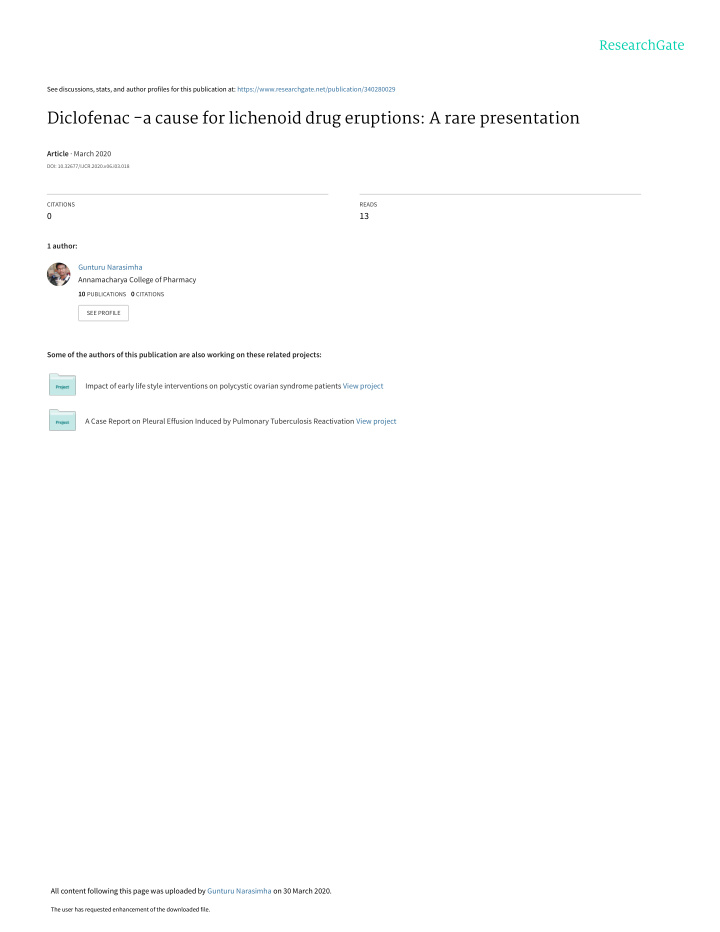



See discussions, stats, and author profiles for this publication at: https://www.researchgate.net/publication/340280029 Diclofenac -a cause for lichenoid drug eruptions: A rare presentation Article · March 2020 DOI: 10.32677/IJCR.2020.v06.i03.018 CITATIONS READS 0 13 1 author: Gunturu Narasimha Annamacharya College of Pharmacy 10 PUBLICATIONS 0 CITATIONS SEE PROFILE Some of the authors of this publication are also working on these related projects: Impact of early life style interventions on polycystic ovarian syndrome patients View project A Case Report on Pleural Effusion Induced by Pulmonary Tuberculosis Reactivation View project All content following this page was uploaded by Gunturu Narasimha on 30 March 2020. The user has requested enhancement of the downloaded file.
Letter to Editor Diclofenac – a cause for lichenoid drug eruptions: A rare presentation Dear Sir, L ichenoid drug eruptions otherwise called as lichen planus are an adverse reaction on the skin associated with the erythematous and pus-filled blisters on the regions of elbows and trunk that are characterized by the presence of itching. We report the case of a younger woman with the lichenoid eruptions that were caused by the administration of diclofenac. An 18-year-old female presented to the dermatological clinic with the symptoms of pruritic lesions for 20 days after Figure 1: Lichenoid eruptions on region of the hand the administration of diclofenac 50 mg tablet for the duration of 5 days with a frequency of two tablets a day for backache. There was no history of cold and cough and there were no such similar complaints in the past. Cutaneous examination revealed itchy papules and vesicles on the left hand and next on the right hand (Fig. 1) followed by the lower limb region of the knee (Fig. 2). No involvement of nail was seen. On general examination, pallor, cyanosis, and icterus were not observed and vitals were stable. Systemic examination was also normal. Her laboratory investigations are normal except for serum Figure 2: Lichenoid eruptions below the knee region glutamic oxaloacetic transaminase: 58 IU/L, serum glutamic pyruvate transaminase: 50 IU/L, and alkaline phosphatase: 160 IU/L. Based on the medication history of the patient, the condition was diagnosed as diclofenac-induced lichenoid drug the variants of drug eruptions. In this condition, there is a failure eruptions. The patient was started on oral cetirizine 5 mg OD, of major histocompatibility complex Class II expression and fusidic acid ointment, and tablet pantoprazole 40 mg OD. After CD25 which is a marker of cell activation [5]. using the prescribed therapy for a week, her condition was In conclusion, these types of reactions are very rare in normalized and eruptions were resolved. occurrence and patients require an immediate treatment and proper Lichenoid eruptions are the popular lesions characterized by flat-topped, shiny papules with the dermal infiltration of counseling on drugs and foods such as cashews and liquorice that inflammatory cells. It is very important to differentiate the various precipitate the lichenoid drug reactions. As the patient visited lichenoid eruptions for the proper treatment [1]. the clinic after 20 days of drug administration and appearance Hence, a correct diagnosis is made based on the physical of symptoms; hence, health-care professionals should counsel finding, laboratory data, and causative drug to establish a the patients regarding the severity of reactions and an immediate correct temporal relation between the reaction and the drug [2]. More commonly, these are associated with the age of above need of visiting the clinic for early resolving the symptoms and 40 years and the latent period for the appearance of reaction conditions. may depend on the type of drug administered as it varies from 1 Gunturu Lakshmi Narasimha to 2 weeks sometimes up to a month or above [3]. In this case, From Student, Department of Pharmacy Practice, Annamacharya eruption tends to appear after 15 days of drug administration College of Pharmacy, Rajampeta, Kadapa, Andhra Pradesh, India (latent period). In this case, there was an abnormality of the liver enzymes. Correspondence to: Gunturu Lakshmi Narasimha, 50/113-A, The previous literature evidence suggests that the liver enzyme Kothapeta, Rayachoty, Kadapa, Andhra Pradesh, India. tests are the important predictor for the cutaneous drug eruptions; E-mail: gunturunarasimha007@gmail.com hence, the liver function test is important clinical evidence that Received - 19 January 2020 in skin disorders, there might be a chance in the alteration of Initial Review - 05 February 2020 liver enzymes [4]. Drug history, examination of lesions, and histopathological studies play an important role in differentiating Accepted - 22 February 2020 Online First Indian J Case Reports 1
Narasimha Diclofenac – a cause for lichenoid drug eruptions REFERENCES Res Dermatol 2018;4:501-7. 5. Rice PJ, Hamburger J. Oral lichenoid drug eruptions: Their recognition and management. Dent Update 2002;29:442-7. 1. Tilly JJ, Drolet BA, Esterly NB. Lichenoid eruptions in children. J Am Acad Dermatol 2004;51:606-24. 2. Mohammed F, Wally LL, Karaban JE, Reddy VB, Lertratanakul Y. Funding: None; Conflicts of Interest: None Stated. Fenofibrate-induced lichenoid drug eruption: A rare culprit. Case Rep Dermatol 2017;9:236-42. How to cite this article: Narasimha GL. Diclofenac – a cause for lichenoid 3. Halevy S, Shai A. Lichenoid drug eruptions. J Am Acad Dermatol drug eruptions: A rare presentation. Indian J Case Reports. 2020; March 08 1993;29:249-55. [Epub ahead of print]. 4. Manne V, Pinjala PP. Drug eruptions and hepatic involvement: A study. Int J Online First Indian J Case Reports 2 View publication stats View publication stats
Recommend
More recommend